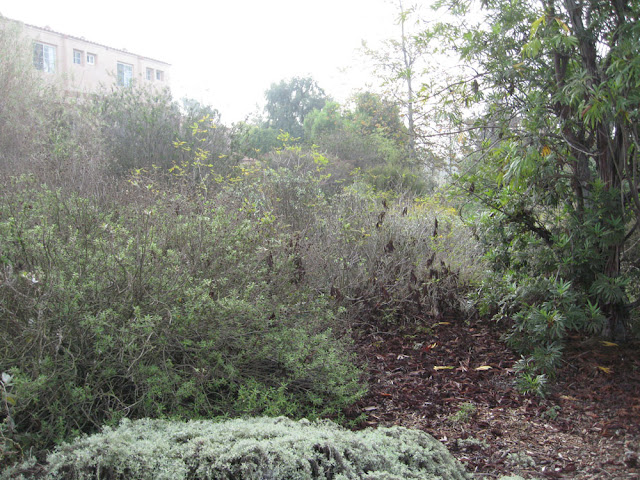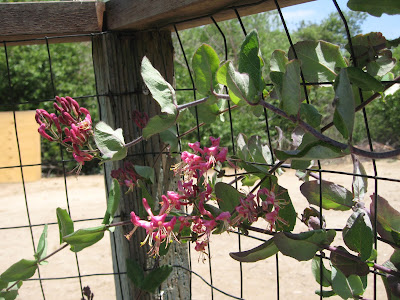 |
| Riparian trees provide good fall color in S. California |
There
are many gardening myths about California native plants (http://www.slideshare.net/cvadheim/california-native-plant-myths-2014). One is that ‘all California native plants
turn brown in the fall’. Some certainly
do – dry season dormancy is a great way to survive our hot, dry summers. But a number of natives are evergreen, or
bloom and fruit in fall. The trick to an
interesting fall garden is to choose plants
specifically for fall color.
Most
people picture brightly colored leaves when they think of fall color. If you
live in a cold climate, bright leaves do
define the fall landscape. But fall
color in mediterranean gardens is a little more subtle. It actually involves more choices – and
greater sophistication - than just ‘planting a maple’.
Provide a Backdrop
One
trick to an attractive S. California fall garden is to plant some evergreen plants. We particularly like the water-wise, evergreen
native shrubs. But any evergreen plants
will do – grasses, sedges, rushes, groundcover perennials, etc. Green foliage looks cool and refreshing;
that’s reason enough to include it in a California garden. But evergreen
shrubs, particularly the larger ones, also provide the perfect backdrop for
fall color.
A
garden is like a theatrical stage. The
colorful flowering plants – and those with unusual shapes and foliage – are the
actors (‘accent plants’). But actors,
whether human or plant, need a stage on which to perform. And an important component
is a backdrop that accentuates their colorful attributes.
A
dark, grayed fence or wall is one option for an effective fall background. Choose a neutral, grayed brown or dark
gray-green with a matt (non-shiny) finish for best contrast. Dark grayed hues fade into the distance, while
providing a neutral backdrop for the plants.
For more on backgrounds in garden design see: http://mother-natures-backyard.blogspot.com/2014/08/designing-your-new-california-garden-11.html
Large
evergreen shrubs are another alternative.
Whether individually, or as a large hedge or hedgerow, shrubs with
medium-to-dark, evergreen leaves provide the perfect background for fall-blooming
plants. We’ll talk more about hedges and
hedgerows next month (November, 2016).
Plants with Fall Leaf Color
If
you want a garden filled with fall leaf color, you’ll need to move some place with
a colder climate. While day length triggers the color changes, cold fall nights
really promote the bright reds and oranges. For more on how leaves change color, see references
1-3, below.
 |
| 'Roger's Red' grape has spectacular fall leaf color! |
A
few native shrubs and vines produce red or purple foliage color in fall/winter
in lowland S. California. The most
reliable is ‘Roger’s Red’ grape, which yields vivid, red-purple leaves - even
in warmer, coastal gardens. With its colorful
leaves and dark, edible grapes, ‘Roger’s Red’ is the closest we get to ‘brightly
colored fall leaves’. In full color,
it’s a sight to behold!
 |
| Mahonia aquifolium leaves can be striking |
 |
| Native currants and gooseberries, like this Ribes speciosum, can be quite colorful in fall. |
A
few other native shrubs are known for their red leaf color. Although evergreen, Oregon grape (Mahonia/berberis aquifolium) and other Mahonia and Berberis species produce some red-purple leaves, if the fall/winter is cold enough. As
our fall/winter temperatures increase, they are becoming less reliable sources
of color in western Los Angeles County.
So, too, are the N. California maples, including the Vine Maple (Acer
circinatum) and the Prunus
species (like Western chokecherry - Prunus virginiana var. demissa). These
can produce spectacular color, but only if the conditions are right.
 |
| Lyonothamnus species make their own colorful mulch in fall. |
Sourberry (Rhus trilobata) has red-orange
fall leaves, and the native Dogwoods (Cornus glabrata; Corus sericea)
are known for their red-brown leaves and bark. Fallen leaves of the Island Ironwoods (Lyonothamnus
floribundus) and Western
redbud (Cercis occidentalis) create a
striking red-brown mulch in the fall. And the fall hues of the medicinal
perennial/groundcover, Yerba Mansa (Anemopsis
californica), are enchanting. These are
the fall reds of S. California; unique touches of color found in few local gardens.
 |
| Anemopsis californica (Yerba mansa) becomes quite colorful in the dry days of fall. |
If you really want red-orange leaves, you may need
to select a non-native tree. A common
choice in S. California is the Sweetgum (Liquidambar styraciflua), with
its reliable red and orange color. Crepe
Myrtles (Lagerstroemia species) produce yellow to orange fall
leaves. We’ve also enjoyed the fall
color and fruits of ‘Anna’ apple and other low-chill apples (Malus domestica
species), Asian pears and pears (Pyrus species and cultivars). These can easily be grown along with native
plants with similar water requirements.
Some
S. California natives produce good yellow colors in fall. Best known are riparian trees like the native
willows (Salix species) and
Cottonwoods (Populus species),
Western sycamore (Platanus racemosa),
Boxelder (Acer negundo) and the
Southern California Walnut (Juglans
californica). All are large trees; in
fact, most are too large for typical suburban yards. The willows and cottonwoods have
water-seeking roots (invade water & sewage pipes). All of the above are also susceptible to the
destructive Polyphagus Shot Hole Borer, a serious emerging pest of wildlands,
parks and gardens [4].
 |
| Western redbud (Cercis occidentales) is showy both spring and fall. |
Several
other winter-deciduous native trees/shrubs turn yellow or yellow-orange in fall. These include the Blue elderberry (Sambucus nigra ssp. cerulea), Western redbud (Cercis
occidentalis), the native Ashes (Fraxinus
dipetala; Fraxinus velutina), California mock orange (Philadelphus lewisii) and the wild roses (Rosa species). These can be better choices for home gardens,
although their colors are not as bright or reliable as the riparian trees.
If
you have a small garden, you can even plant the wild roses, Narrowleaf willow (Salix exigua) or Yerba mansa in a large
container. A single pot may satisfy your
craving for fall leaf color. For a
complete list of native plants (appropriate for lower-elevation S. California)
with fall leaf color see:
Plants with Fall Flowers
While
cold-climate areas excel at fall leaf color, our local native plants surpass
them with fall flowers, fruits and seeds. Cold climate gardeners envy our long fall growing
season and color palette. Some local native
plants are at their best in the shorter days of fall.
 |
| Native Goldenbushes (like this Hazardia) provide reliable yellow flowers, even in a very dry fall |
Shrubs
in the Sunflower family provide the most spectacular fall yellow and gold
flowers. If you love yellow, fall is a good season! At the pale end of the spectrum are Mulefat (Baccharis salicifolia) and Coyote bush (Baccharis pilularis). Most of the rest have brilliant yellow-gold
flowers in abundance. Among the best
are the larger Goldenbushes (Hazardia species and Isocoma
menziesii), the mid-sized Rabbitbush (Ericameria
nauseosa) and other Ericameria
species and the smaller Butterweed (Senecio
flaccidus var. douglasii), Matchweed
(Gutierrezia californica), the Goldenrods
(Solidago species) and Telegraph
plant (Heterotheca grandiflora). The tall Annual sunflower (Helianthus annuus) may also bloom in the
garden setting in fall.
 |
| The fiery flowers of Epilobium are a fall treat! |
If
red and orange flowers are more to your taste, you can’t go wrong with the
California fuschias (Epilobium canum and
other Epilobium species). California fuschia and its cultivars are
prized with good reason. They come in colors ranging from white to brilliant
red. They are bright, colorful,
water-wise and produce lots of fall blooms in a good year. Epilobiums
are a good, low maintenenace investment.
 |
| Mimulus cardinalis often blooms again in fall. |
 |
| Diplacus species and cultivars are also good for fall color. |
Several
red/orange flowering plants may bloom again in fall, including the Baja
fairyduster (Calliandra californica),
Catalina
snapdragon (Gambelia speciosa) and Chuparosa
(Justicia californica). The Scarlet monkeyflower (Erithranthe/Mimulus cardinalis), the shrubby
perennial monkeyflowers (Diplacus
species and cultivars) and the Monkeyflower savory (Clinopodium mimuloides), all of which like a little shade and
water, also come to life again in fall. If
you need a colorful porch pot, these are a good bet for late summer and fall.
 |
| Symphyotrichum chilense (Aster chilensis) |
 |
| Pluchea odorata is spectacular in fall |
The
most reliable purple flower of fall is the Coast aster (Symphyotrichum chilense (Aster
chilensis)), useful as a ground cover or pot plant. Pink-blooming fall natives include the
spectacular Sweetscent (Pluchea odorata)
and Arrowweed (Pluchea sericea). For scent, plant the Brickelbushes (Brickellia species); their sweet
fragrance at dusk is a welcome addition to the fall garden.
Plants with Colorful or
Showy Seeds, Seed heads or Fruits
 |
| Fall colors in a S. California garden |
Some
of our most spectacular fall color comes from seeds, seed heads and
fruits. At the top of the list for seed
color are the native Buckwheats (Eriogonum
species). While some buckwheats bloom
into fall, most are going to seed. And
oh, what a show they create! Colors
range from pale brown to rust and dark brown. The seed heads may be small and round or large
and flat, depending on the species. They add color and interesting shapes from
summer through fall.
 |
| Native buckwheats (Eriogonum species) provide rich rusts and browns. |
If
you want a colorful fall garden, plant several species of native
Buckwheat. They are easy to grow,
water-wise, and excellent pollinator and bird habitat. They will become the backbone of your fall
garden. They are local treasures!
 |
| Helianthus annuus provides food for finches |
Many
of the fall-blooming Sunflowers, Creambush (Holodiscus discolor), and warm-season grasses also have showy seed
heads in fall. Don’t be too anxious to
prune them; migrating birds need their seeds for food and they add color and interest
to the garden. For suggestions on fall pruning of native
plants see: http://mother-natures-backyard.blogspot.com/2014/11/maintaining-your-new-california-garden_15.html
And
then there are the colorful fruits of fall.
The most showy – and well-known – are the red fruits of the Toyon (Heteromeles arbutifolia). Another common name for this large shrub is
the California Christmas berry. With
climate change, we may have to rename it 'Halloween berry' – it’s coloring up
earlier every year! The fruits provide spectacular color, as well as food for
fruit-eating birds. Toyon makes a
spectacular espalier along a wall.
 |
| Native wild grapes are edible and showy. |
Native
grapes ripen in late summer or fall. The dark fruits contrast beautifully with
the fall leaf color (red or yellow). Other
native shrubs may still have colorful fruits in fall. These include the native currants and gooseberries
(Ribes species), Western chokecherry (Prunus virginiana
var. demissa), Netleaf hackberry (Celtis reticulata), Summer
holly (Comarostaphylis diversifolia ssp. planifolia),
California coffeeberry (Frangula/Rhamnus californica) and Silver
buffaloberry (Shepherdia argentea).
Of course, the non-native
persimmons and pomegranates are also spectacular (and delicious) in fall.
 |
| Native honeysuckles (Lonicera species) have showy berries. |
Even
the native honeysuckles (Lonicera
species), boxthorns (Lycium species),
nightshades (Solanum species) and the
native roses will have colorful fall fruits in a good year (or with a little
supplemental water). Contrast them with
the white berries of the snowberries (Symphoricarpos
albus and S. mollis), which
remain on their bushes well into winter. For a complete list of native plants
(appropriate for lower-elevation S. California) with fall flower, seed and
fruit color see:
We
hope we’ve inspired you to plan a little color for your fall garden. Southern
California’s native fall color is different from that of New England, but it is
every bit as lovely. The peaceful
colors of a local fall garden are soothing and restful; they fit in with the
landscape. And while the colors don’t
jump out and grab you like the reds of a fall maple, they are beautiful in
their own right. Savor them like a fine
wine; they are part of our California natural heritage.
__________________
- https://www.na.fs.fed.us/fhp/pubs/leaves/leaves.shtm
- http://www.scientificamerican.com/video/why-do-autumn-leaves-change-color-2013-10-03/
- http://www.goodhousekeeping.com/home/a18922/why-do-leaves-change-color-0909/
- http://ucanr.edu/sites/socaloakpests/Polyphagous_Shot_Hole_Borer/
We
welcome your comments (below). You can
also send your questions to: mothernaturesbackyard10@gmail.com


















